The plenty rose "Sympathy" is one of the most popular varieties of curly large-flowered roses. This is exactly the case when the spectacular appearance is combined with the unpretentiousness and vitality of the plant. Large velvety scarlet roses bloom abundantly and long, almost the whole season. Perennial curly culture fits perfectly into any landscape compositions, ideal for vertical landscaping and design of architectural structures. How to grow a plenty rose on his site? What care to provide culture? Consider stages all the features of growing rose sympathy in its garden.
Rose Pleet, Plant Features
In the international flower classification, it is customary to share all the plenty roses into 3 groups:
- Curly roses ("Ramblers"). They are distinguished by long flexible shoots up to 5-6 meters long and small flowers (for 2.5-3 cm in diameter). Abundant flowering of these varieties of roses is observed no more than one month. Plants are frost resistant and hardy.
- Pleetous large-flowered roses ("Clywimer") were formed as a result of crossing roses - "Ramblerians" with different removable varieties of roses. Looping shoots reach a length of about 4 meters, the inflorescences are large (up to 4 cm in diameter) and loose. The varieties of this group, to which the hybrid variety of "sympathy" also relates long, "wave-like" (splashes and downsion), twice for the whole season.
- Large-flowered bush roses ("cliviages") are distinguished by large single inflorescences (up to 10 cm in diameter) and weak frost resistance.
Rose Pleaf Sympathy, Description of the variety
All representatives of the plenty varieties of roses are perennial flowering garden plants. The "progenitor" of most branched roses is an ordinary rose robber, crossed with certain varietal roses with long shoots.
- Pleetry Rose "Sympathy" is one of the most popular branching roses among flower water. The variety was removed in the second half of the 20th century by the famous breeder of Germany by Wilhelm Cordes.
- The sympathy rose refers to the group of large-flowered re-flowering plenty roses, called "claimimers".
- The height of the adult bush of the plenty rose reaches 4.5-5 m, the diameter is 1.5-2 m. Such impressive dimensions of the branched plant allowed us to use a rose in landscape design of various fences, arches, walls, etc. Therefore, when planting this kind of roses, it is important to consider the need for a strong and reliable support for shrub.
- Rose plenty sympathy is not only a spectacular shrub habit, but also beautiful flowers. Terry, fragrant, saturated scarlet, large (in diameter up to 10 cm), the inflorescences abundantly cover the curly shoots of perennial and look very attractive against the background of green foliage. One such lush flower consists of about 20-25 petals.
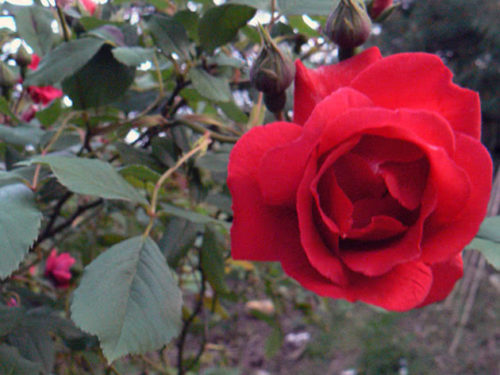
- Pleetic varieties, unlike habitual, bush roses, grow and develop very quickly. At the same time, the culture blooms for a long time and abundantly. The flowering of the curving rose of sympathy begins at the beginning of summer and ends with the onset of the first cold. The first wave of flowering is the most abundant, then a slight decline begins, after which the bush blooms again, but is not so magnificent, as at the very beginning.
- At open solar sites, bright red rose petals sympathy do not fade and do not flex, after the rain there are no spots or divorces. The sort of hardy, frost-resistant, is not afraid of temperature differences and quickly adapts to different climatic conditions. This rose variety is highly resistant to various diseases and pests.
- You can grow a plenty rose sympathy as in a warm mild climate and in the middle lane of Russia, with a difference only in care for the winter period. In the first case, roses for the winter are not covered, and in the second - remove from support and insulate for the period of winter cold.
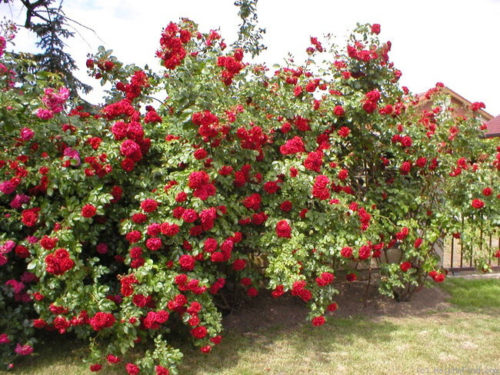
Rose plenty sympathy, reviews
- Flower reviews that grow in their garden "Sympatia" Rose unanimously "praise" unpretentious beauty, noting the beauty of bright inflorescences and the overall endurance of the plant, which is important in conditions of various climatic zones.
- Most of the owners of this rose variety note its high frost resistance and durability not only for temporary drought, but also to protracted rainy periods. Even if the plant frightened a little in winter (without shelter), it quickly restores and increases the green mass in the spring, with the onset of heat.
- You can buy sympathy rose in any flower shop, nursery, on specialized exhibitions - sales or online networks. The main condition for the successful purchase of a varietal rose is a reliable and verified "seller".
Rose plenty sympathy, agricultural landing
In order for the branching rose of sympathy as much as possible its natural decorative qualities, it is important to initially choose a place for planting culture, ensuring it with due attention and necessary care.
The choice of a site for planting a rose of sympathy must be 100% correlated with the needs of this plant. In addition, due to the characteristics of the structure, it is important to take into account the need for a support for weaving roses shoots: the frame or rods are knocked into the ground in advance (or during the planting of the plant). Also, seedlings can be planted near the finished support (walls, fences) at a distance of not more than 0.5 m.
Place of Planting Press Roses Sympathy
- The plot should be sunny, well lit, but closed from drafts or gusty winds.
- Especially unacceptably the constant impact of cold northern or northeastern wind flows.
- Ideally, in the first half of the day the Sun brightly covered the plot, and after the hot noon - the shadow of the buildings or garden trees was slightly contacted.
- The best area for planting roses is the southern side of any building. In such a place, the plant will provide the most abundant and long-lasting flowering.
- Given the vertical growth of shrubs, the large space for the plant will not need.
- To reduce the risk of infection with fungal diseases, you should not land roses bushes next to the fruit trees.

Landing Time Looks Sympathy
- Looking out seedlings of plenty roses in spring and autumn.
- The autumn landing deadlines have proven better (from the second half of September to mid-October), when, before the start of frost, the seedlings manage to root and even "give" new shoots.
- Spring dates for planting seedlings fall on April-May months. When planting in the spring, the plant develops slightly longer and is unlikely to bloom in the same season.
Soil for planting plenty roses sympathy
- Soil on the site should be fertile and water permeable. If the soil waters run too closely, the bushes are planted on artificial elevations so that long roots (up to 2 m) of the perennials are not discharged under the influence of constant moisture.
- To avoid water stagnation in the zone of the root plant of the plant can also be by landing the rose on a small slope or natural elevation. Wetlands for planting perennials will not fit.
- Best soil for roses are given nutrient moisture-intensive loams with a weakly acidic reaction of the medium.
- In heavy clay, the soil will be required to add sand, and in a small sandy - organic fertilizers (humus, humus, bone flour).
Preparation of a plot for plenty rose sympathy
- Plot for planting seedlings of pleate roses is preparing in advance: 1-2 months before the alleged landing.
- If the rose is planted in the spring, the plot is prepared in the fall.
- For this, the ground on the site is drunk with simultaneous fertilizer. 1 M. 2 Earth will need about 100 g of humoring, 50 g of superphosphates, 40-50 g potassium and 200 g of wood ash.
Preparation of seedlings of plenty rose sympathy
- If the purchased seedling of the plenty rose needs transportation, it is better to preliminarily win his roots in the so-called. "Clayey Battle" to prevent them drying until the point of landing.

- Immediately before planting seedlings with an open root rose root system soaked for a day in water. After that, the leaves are broken, and shoots, and the roots of young bustle are cut into about two kidneys (they leave about 30 cm). Also remove all immature or damaged shoots. Large cuts fall asleep with a crowned coal.
- If the cooked seedlings are grafted (on a rosehip, for example), it should also be removed all the kidneys below the vaccination location so that they do not give the root rose hips.
- After all the preparatory procedures, seedlings should be disinfected. For this, the roots of the plant are immersed in a 3% solution of copper sulfate.
Landing Landing Technology Sympathy
- The landing pit is initially prepared, about 0.5 x 0.5 m.
- On the bottom of the pit, the drainage material is embanked in the form of a rubble or broken brick. The fertilizers are made from above: wood ash, manure, superphosphate, etc., mixed with the top layer of the soil.
- The soil is abundantly shedding with water and on a small soil hormick (in the center of the landing pit) a rose sapling is exhibited.
- The roots of the plant are straightened to avoid bends and refractions, after which the soil is covered. As the soil is plugged, the seedling is important to hold his hand to keep it vertical location. It is also important for foot to seal the soil in the area of \u200b\u200bthe priority circle to avoid the formation of unwanted air emptiness in the soil.
- Laying on the site several copies of the plenty rose, leave the interval between plants at least 1 meter.
- When planting a rose, it is important to pay attention to what plants were purchased: Corresponding Saplings or Saplings of Roses Vaccused on Rosehip. Thus, the depth of planting grafted on a rose rose should be greater that the vaccination place is 10-15 cm below the ground level. Leaving the vaccination place is not protected (on the surface), the plant will most likely die. As for the rose core saplings, it is deepened in the soil so that the root neck is closed with a 5-centimeter soil layer.
- After planting, the plant is abundantly watered with water and plunge the trunk at a height of about 20 cm.
- If roses seedlings are planted in the spring, it is better to further cover the film, creating, so on, greenhouse conditions for better rooting of the plant. Such a "mini-greenhouse" is necessary to ventilate daily until steadily warm weather. Then the shelter is completely removed, and the rolling circle is mounted, for example, peat.
- In the first year after the spring landing, all buds with a bush are better to disrupt, as the plant should fully grow and dial up to winter.
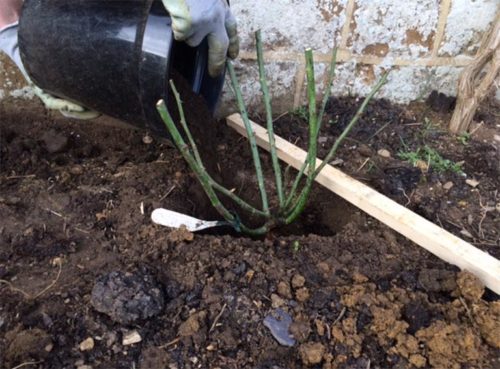
Transplanting roses sympathy
- An adult rose bush is transplanted only in case of extreme necessity, when, for example, it was unsuccessful selected place for the curly rose.
- Pereparing a perennial is better in the first half of the fall (in September-October) so that the plant will have to root in a new place until winter. If it is decided to transplant a bush in the spring, it is necessary to do this after the warm weather has been established, but before the kidneys blossomed.
- To rose as less traummatically transferred the transplant process as possible, it is necessary to gently remove all branches from the support and trim their half-length. Then the bush is drove at a distance of about 40-50 cm from the trunk, trying to preserve the root system as much as possible and gradually deepening in the ground.
- Thus, I dug the entire bush, slightly shake the ground and cut damaged (torn, shaggy) roots.
- The shredded bush of the plenty rose is transplanted into a new place in a pre-prepared landing pit by analogy with the above-described plant landing technology.
Rose Pleet Sympathy, Care Features
Caring for plenty roses, as well as other types of roses, is to perform the main agrotechnical events: watering, loosening, feeding and trimming. The only exception of a branching culture is the mandatory garter of long rose weaves to any support.
Observing such "non-good" rules, roses will provide their owners a lush abundant blossom over the years.
Watering and loosening roses sympathy
- The plenty types of roses are considered pretty drought-resistant plants, so they do not need to water too often. It will be enough abundantly (1-2 buckets) moisturize rose bush 1 time per week.
- So that water during watering does not spread through the site, a rolling circle should be made with small earthy "sides". For watering, it is best to use resistant water.
- A few days after irrigation, in order to avoid the formation of a dense crust, the soil loose or mulched. As a mulch, you can use such materials as: peat, sawdust, wood bark. The mulch will allow for a long time to save the wet microclimate around the plant and will prevent the germination of weeds. In the case of mulching the rose bush, the frequency of irrigation is reduced.
Feeding and fertilizer rose sympathy
- Subject to roses, with a sufficient amount of mineral and organic fertilizers, the first 2 years of plenty roses do not need to feed, they will have enough nutrients embedded in the soil.
- At the 3rd year of the life of seedlings, under the bush, they begin to make fertilizers. Pretty roses are favorable for making such organic fertilizers such as manure, wood ash, etc.
- In the autumn, the plant needs potassium-containing feeders that allow the shrub better to prepare for the upcoming winter. You can use ready-made fertilizers designed for flowering plants, or add wood ash to ground. In addition to potassium, the ash is a source of such valuable elements as calcium, magnesium, phosphorus, sodium, etc.
- Feel the primer is best in spring and autumn, and during the flowering period, the feeding is better not to make.
Garter and trimming roses sympathy
- Long lettuce branches of sympathy roses need a mandatory garter to the support. Supporting can serve as nearby buildings, fence, arch, and made independently metallic structures (arches, grilles). Pour the support structure is needed not closer than 30-50 cm from the bush.
The plastic twine is best used as a tapping material, which does not injure the stalks of the plant. Rose, landed at the wall at home or by its facade, is configured to a conventional chopler.
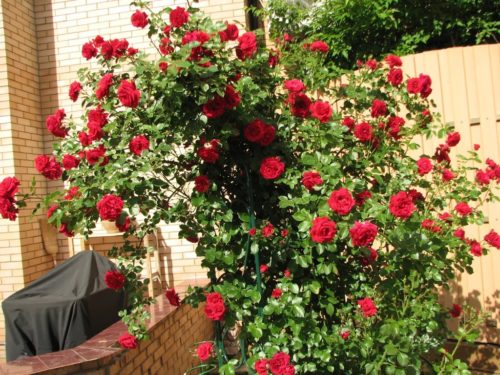
- Supporting design should be periodically examined so that they, under the weight of the branches, do not break and damaged the plant. Not all "whips" should be directed upward, otherwise the buds will be located only on the top. Several main stems should be tied in a horizontal position, giving shrubs more compact and dense structure.
- As it grows, the rose bush needs forming pruning. Pruning provides proper formation of the crown, stimulates abundant flowering and attached to a busty effect decorative look.
- Pruning spend in spring and autumn. In the spring, all patients are removed, damaged, dry or thinned shoots, and also cut off the ends of the shoots to a strong exterior kidney.
- Given the fact that the plenty roses for 3 years on the main shoots form the blooming branches of different orders, the flowering of these shoots to the 5th year weakens, so the main shoots of early spring is better to cut to the base. A similar "cardinal haircut" is carried out after the 4th year of life.
- In the fall from the bush, all the sworded inflorescences are cut and cut down too thickened or branched stems.
- Special attention needs to be given to young vaccinated roses saplings, because within 1-2 years after landing, the cultural lead is weakly developing its own root system, but the roots of the rose hips, on the contrary, give an abundant pig, which is necessary to delete. After a few years, the Rogishnik's root is completely outstanding, and the pigstream can only give the roots of the cultural lead.
Fighting diseases and pests of rose sympathy
- From the pests, the plenty of the sympathy rose can damage such insects as: a wave, a web tick, a rosal sawdle, leaflers, cicades, trips.
- At the first signs of the appearance on a bush rose, it is possible to start its extermination with the help of folk remedies. To do this, you often use a soap solution from grated on the grater of the economic soap, which spray all the plant. If the twilty, a lot or soap solution did not give positive results - use the insecticidal drug from the Tly.
- The web tick, as a rule, appears as a result of improper care, when the plant lacks moisture in the hot period of summer. Pliers appear on the bottomside of the sheet plate and form a characteristic web. As a result of the vital activity of these pests, the leaves acquire a gray tint, begin to dry and wither. To get rid of the web ticks for a start, you can try to spray a bush of roses with an infusion of wormwood, yarrow or tobacco (0, 5 kg of green mass on 10 liters of cold water, insist 2 weeks, strain and dilute with water at the rate of 1:10). If the situation does not require deposit, it is better to treat the plant insecticide (for example, phytodeterm). Re-processing is carried out in another 2 weeks.
- As for the rest of the pests of roses, they are rarely docked if the plant's competent care. Good "neighbors" for roses bushes will be the vita flowers, scaring many insect pests. As a preventive measure, the annual spraying of roses borodovoy liquid (in spring and autumn) is suitable.
- Of the diseases of roses can be affected by coniocyerium, bacterial cancer, milderous dew, gray rot and black spot.
- Bacterial cancer is one of the most dangerous diseases, heal which is almost impossible. First, the plants appear hubbles that begin to harde and darken, after which the rose bush dry out. It is important at the very first signs of the disease to crop the damaged parts of the plant and treat the sections with a solution of 2-3% copper sulfate. To protect yourself from this disease, it is necessary to carefully inspect rose saplings when buying, and before planting to treat the roots in the copper sulphate solution.
- Coniocyurium, a fungal disease, which is also called the "bark burn". The first signs of defeat are found in the spring when winter shelter is removed from roses bushes. Then, on the branch branch you can see brown spots, gradually darkness and turning into a ring around the escape. Such shoots need to trim immediately, and in order to avoid further infection, cut into another part of the healthy tissue. Sliced \u200b\u200bparts better burn. To prevent the appearance of the fungus, it is necessary to periodically air the covered bushes of roses during thaws and not to make nitrogen fertilizers in the fall, on the eve of wintering.
- If the plant appeared on the plant, which acquires a brown color with time, - we can talk about the appearance on the shrub of mildew. The main factors provoking the appearance of the disease are: an increased level of humidity, sharp fluctuations in the temperature regime, irregular watering and oversupply nitrogen in the soil. In the fight against pulmonary dew, all the affected areas are removed, and the plant is sprayed with a solution of copper (2%) or iron (3%) of the vitriol. The preventive measure will be the treatment of a plant with a calcined soda with soap (every 2 weeks in the summer).
- Black spot is manifested by the appearance on the foliage of dark brown spots with a yellowish edge. Over time, the sizes of stains increase, merge, and the leaves are pretended prematurely. The struck rose bush (and the soil under it) should be treated with a bordrian liquid solution (3%) with a repeated procedure after 2-3 weeks.
- A fungal infection, gray rot, is striking all ground parts of plants, significantly reducing their decorativeness. At the first signs of the disease, the culture must be treated with a burgundy fluid solution. Then, with an interval per week, repeat the procedure twice twice.
Preparation for winter rose sympathy
- Pleet roses need shelter for the winter only in cold regions with harsh winters. Roses prepare for wintering stages.
- First, the autumn trimming of old branches that do not form buds or thickening the crown of the plant are performed. During this period (in the first half of the fall), watering and fertilizers are stopped.
- Then remove all the dry leaves, and the soil under the bush spray with any disinfectant.
- And the latter, most importantly, the event - the screens are neatly removed from the support, bend to the ground, fixed with brackets or spikes (without laying onto the ground) and cover with any protective material (spong branch, sponge, film). The procedure is carried out in dry weather at temperatures below +5 0WITH.
- Another embodiment of the shrub is the shelter of the rose weeping, without removing them from the design. For this, the cluster is fixed around the bush with a twinestone, which is turned on top of the agriculture.
- Any observer material should not be too tightly fit to the rose bun, it is better to leave some space for air circulation.
- The rolling circle also protects, pouring around the trunk of a thick peat layer with the ground.
- It is necessary to remove the shelter in the spring, after thaw.
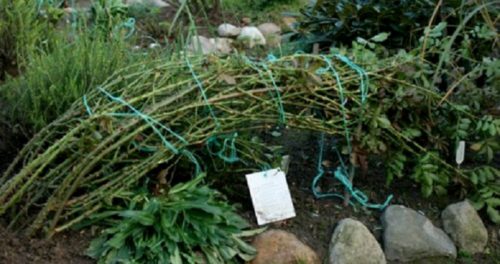
Rose reproduction sympathy
Pleet roses multiply vegetative (cuttings, glowing, vaccination) and a generative way (seeds).
- The best way to reproduce the plenty rose is shilling. The cuttings are harvested in summer or winter. The shoots cut (making a slant cut) with healthy bushes after flowering. Full cuttings should have at least 4 kidneys. From the bottom of the shoots remove the leaves and plant them into the soil substrate (sand from the ground). The cuttings are covered with a glass jar and assign in the shaded place. Watering roofing cuttings is carried out as the soil dried.
- The reproduction of the tanks is also a fairly effective and simple method of breeding the plenty rose of sympathy. The lower escape of roses is laid in the groove, pre-taking an incision under the kidneys (for the formation of roots). Escape puts off the ground, provide regular watering. With a favorable outcome, the next spring, the chain will start the roots, which means it can be separated from the parent plant and put it separately.
- The vaccination of the church of the cultural rose to the root of the ridge is called the eyepiece. Conduct this procedure in the second half of summer. To do this, a T-shaped incision is made on the root neck, fashioning the bark and slightly pulling it up. With a cutlets of the plenty rose, the kidney is cut together with the adjacent bark and the layer of wood, tightly placing it in the cut on the rosehip. The place of vaccination is tightly wrapped with an inhabituation film. Then the rose rose bush plunges above the vaccinations of 5-10 cm. After 2-2.5 weeks, the film weakens, and in the spring of next year completely removed.
- Seeds for landing roses are bought in specialized flower-garden shops. This method of reproduction cannot guarantee 100% of the preservation of the varietal signs of roses. Seeds are lowered for 30 minutes into a container with hydrogen peroxide, for disinfection and disinfection. Then all seeds are folded onto cotton, also moistened with hydrogen peroxide, and placed in a refrigerator for 1.5-2 months, for further stratification. After the expiration of the specified time, the sprouted seeds are planted into peat pills or individual pots. Seeding is carried out under normal conditions, providing a 10-hour day and regular moisturizing seedlings. Those and strengthened seedlings are transplanted to the shovel into the street.
Rose Pleaf Sympathy, Application in Landscape Design
- The main purpose of the plethious rose of sympathy is the design of the vertical zones of the landscape in combination with small architectural forms.
- Flowering branching culture is indispensable for landscaping decorative columns, stelera, arches, when decorated and decorating arbors, terraces, balconies, fences or ordinary walls.
- The sympathy variety rose can be prepared on the support in different ways: arbitrarily, with a slope, "fan" or according to the configuration of the proposed support. It is also possible to create an arcade when the arches alternate with different scattering roses.
- As most of the curly roses, the "sympathy" is slightly taken from the bottom, so the experienced flowers plant a variety of flowers: carnations, bells, gypsophiles, jasolki, lavender or sage.
Rose plenty sympathy, growing problems
Consider the most common problems arising in the cultivation of plenty "sympathy".
- Pleet rose "Sympathy" does not bloom. Possible causes: a variety discrepancy, an unsuccessful location for the plant, a non-fermentation of the soil composition, frozen shrub in winter.
- The plenty rose "Sympathy" blooms not all over the height of the bush. Possible reasons: shading a bush from below neighboring plants or a support itself, a purely vertical tapping of a row without horizontally spaced shoots.
- Pleet Rose "Sympathy" has a pale color of inflorescences. Possible causes: insufficient lighting, cold climate.
- The plenty rose "sympathy" forms small inflorescences. Possible reasons: The blurred inflorescences were not removed.
Thus, by many flowers beloved by many, the variety of "sympathy" roses practically does not need advertising. Possessing such advantages as: a spectacular appearance, unpretentiousness, endurance, resistance to diseases and frosts, a long period of flowering, plenty rose is capable of occupying leading positions among favorite garden flowers.



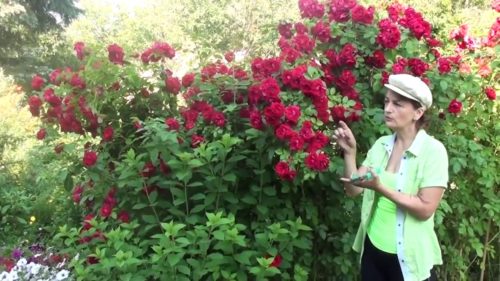
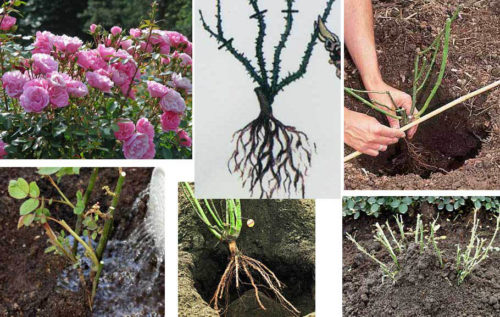
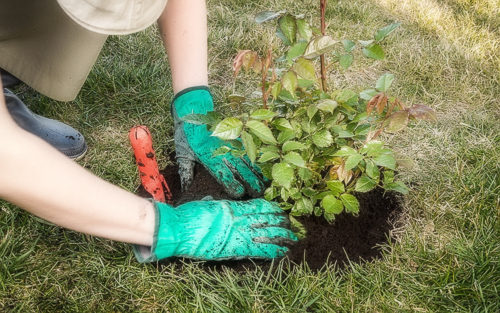
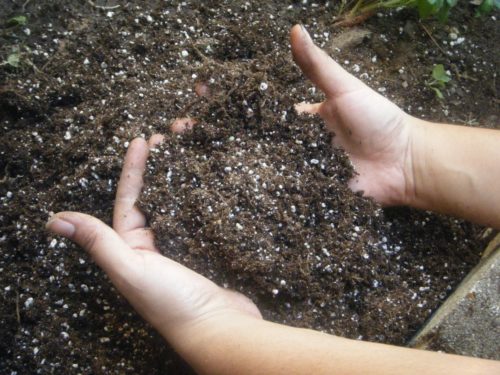
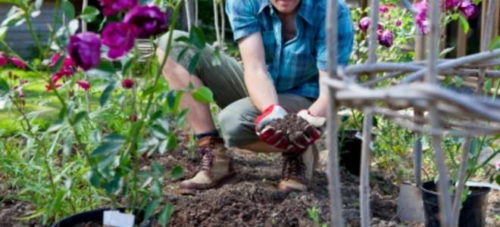
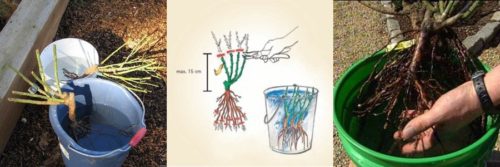
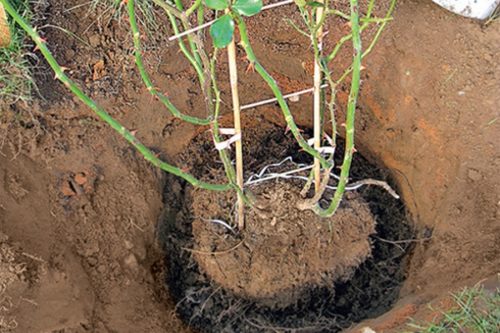
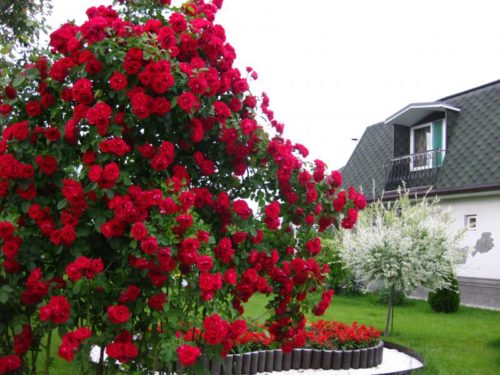
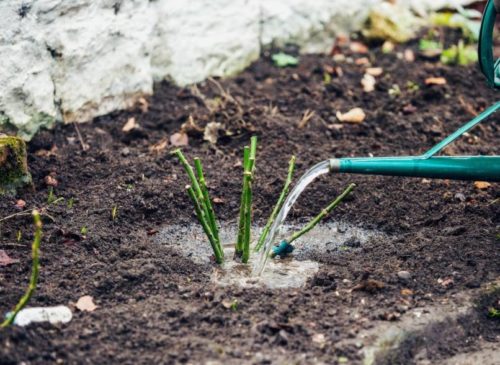

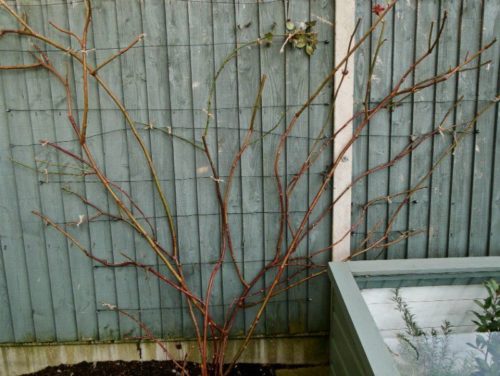
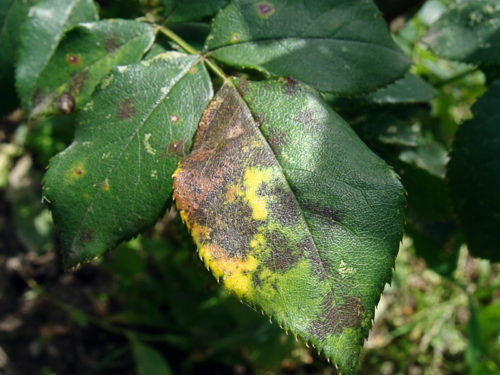



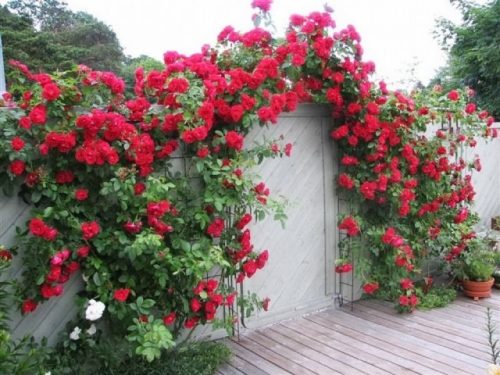















 Start a discussion ...
Start a discussion ...